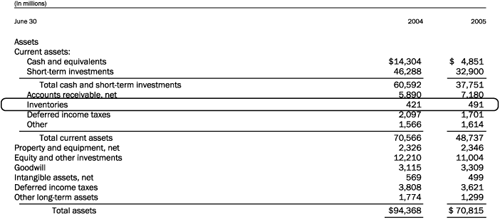Inventories
Inventories represent goods waiting to be sold, and direct (and sometimes indirect) costs associated with the production or procurement of these goods. The composition of inventories depends on the nature of a company’s business; they typically consist of three major categories:
Raw materials: used in the manufacture of the finished product such as crude oil, food products
Work-in-process: products in the process of being manufactured such as cars/computers in the middle of assembly
Finished goods: products that have been completed and are ready for sale such as clothes, books, cars

Inventories are linked to COGS on the income statement. Suppose a company sells $50 worth of inventories during the year:
| Debits | Credits | |
|---|---|---|
| COGS (SE) | 50 | |
| Inventories (A) | 50 |
Get Crash Course in Accounting and Financial Statement Analysis, Second Edition now with the O’Reilly learning platform.
O’Reilly members experience books, live events, courses curated by job role, and more from O’Reilly and nearly 200 top publishers.

